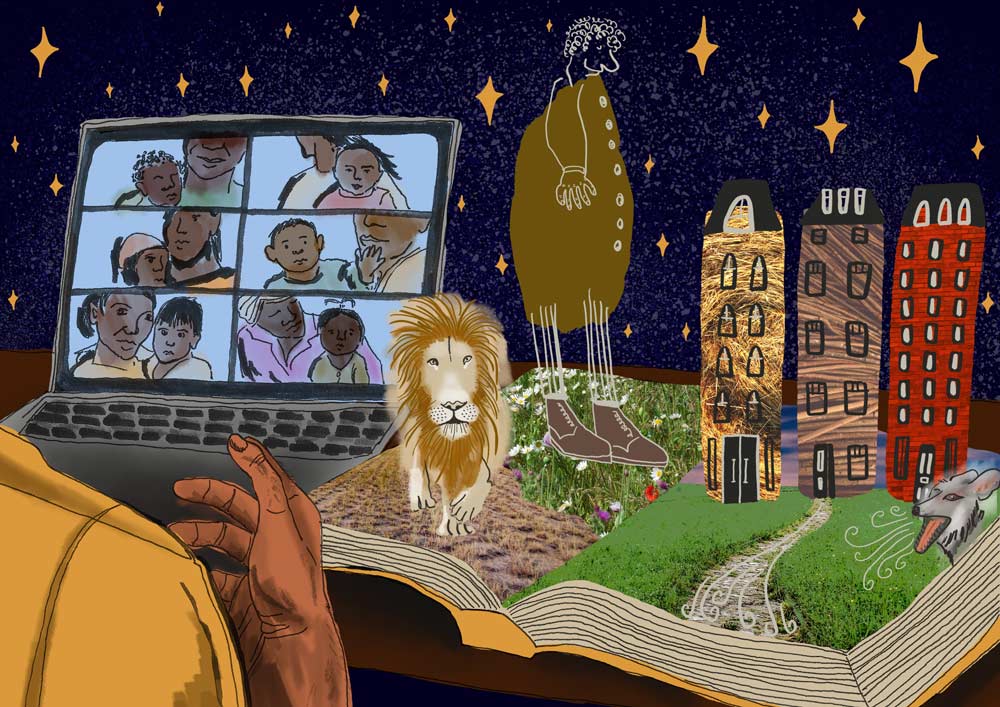Storytelling at Bristol Refugee Rights

The illustration by Laurel Molly. Find her on Instagram @laurel_molly.
What stories to tell? When the Welcome Centre had to close down because of Coronavirus 19, Anna Burness, who runs the Early Years Project, suggested a weekly Zoom meeting with parents and children. This would include my telling a story. So, instead of being down on my hands and knees amongst the Lego at the creche, I now had the job of deciding which stories would work best for very young children.
At first I tried traditional tales with a feminist twist – so in my version Maid Marian rescued Robin Hood when he was captured by the Sheriff of Nottingham, and it was Guinevere who persuaded Arthur to pull the sword out of the stone. The other possibility was favourite stories from my own personal experience – diving into Bristol harbour when my wife fell in (a completely pointless rescue as she is a strong swimmer).
I got my five grandchildren to do the illustrations and Anna worked out a way of bringing up the images on the screen as I told the stories. The idea was that this might inspire the parents and children to do likewise – to tell their traditional or personal stories and then to have them illustrated by their own children.
But that was asking a lot, especially as most parents did not feel confident about their English. So we changed tack and I began to look again at the wonderful stories that I had once read to my children and was now reading to my grandchildren. Too many of them had white children as their central characters but some seemed to be possible candidates.
Oscar Wilde’s story The Selfish Giant especially so. I had been moved when reading it to my own children, especially the moment when the Giant, who had driven the children from his garden, changes his mind. He lifts the smallest child into the tree “and the tree broke into blossom and the birds came and sang on it.” Reading it to an audience of refugee children and their parents, it was impossible not to think of those who had been forced to leave their own homes and were unlikely ever to return to “the most beautiful garden they had ever seen.”
The edition of the story that I had found was sensitive to ethnicity and in the beautiful accompanying illustrations by Alexis Deacon, at least one of the children in the garden is wearing a hijab. I come from a filmmaking background so am very much aware of copyright issues but feel that no artist or writer would object to the non-commercial use that we are making of their words and pictures.
When I dug out a battered copy of Zookeeper Zoe (made by Boots Opticians to help identify colour blindness!), I was pleased to see that it is a brown girl who helps to solve a problem at the local zoo. And there are many stories where issues of ethnicity and gender are avoided by making everyone an animal. So Anna and I have used lots of those, traditional ones like the Three Little Pigs and more recent ones like The Lion Inside.
The central Bristol branches of both Foyles and Waterstones offer a huge choice of children’s books but a lot of these, while vividly illustrated, have worthy messages but no story line to engage the children’s attention. My name is not Refugee says all the right things – “You’ll be called Refugee but remember Refugee is not your name” – but seemed to me to stress the sad situation of all too many asylum seekers and to be totally unsuited to our storytelling sessions.
Julia Donaldson, the author of brilliant books like The Gruffalo, rightly objects to what she calls “books as medicine”, those with a heavy social message. She demonstrates that it is possible to get over a point with an engaging story – and to provide a few chuckles too. So too do Rachel Bright and Jim Field in their book The Lion Inside. Our viewers/listeners enjoyed joining in as the mouse learned how to ROAR and hopefully will remember
“that, no matter your size
We all have a mouse and a LION inside.”
Rhyme always helps and I must confess that another factor in my choice of a story is whether it gives me an opportunity to play roles – squeaky Little Billy Goat as well as the snarly (but not too alarmingly snarly) Troll. I seized the opportunity in that one, and in The Ugly Duckling, to sing too.
When I read stories to my grandchildren, I can watch out for audience reaction, see what stories go down well and which ones they are beginning to outgrow. Mighty yawns are a bit of a giveaway. It is more difficult to assess this on Zoom, but Anna is brilliant at keeping the children involved, remembering their names and getting them to suggest singalong songs.
Hopefully, we are getting something right – twenty-three children have taken part so far, and we will be keeping the weekly on-line sessions going until the coronavirus nightmare is over.
Colin Thomas